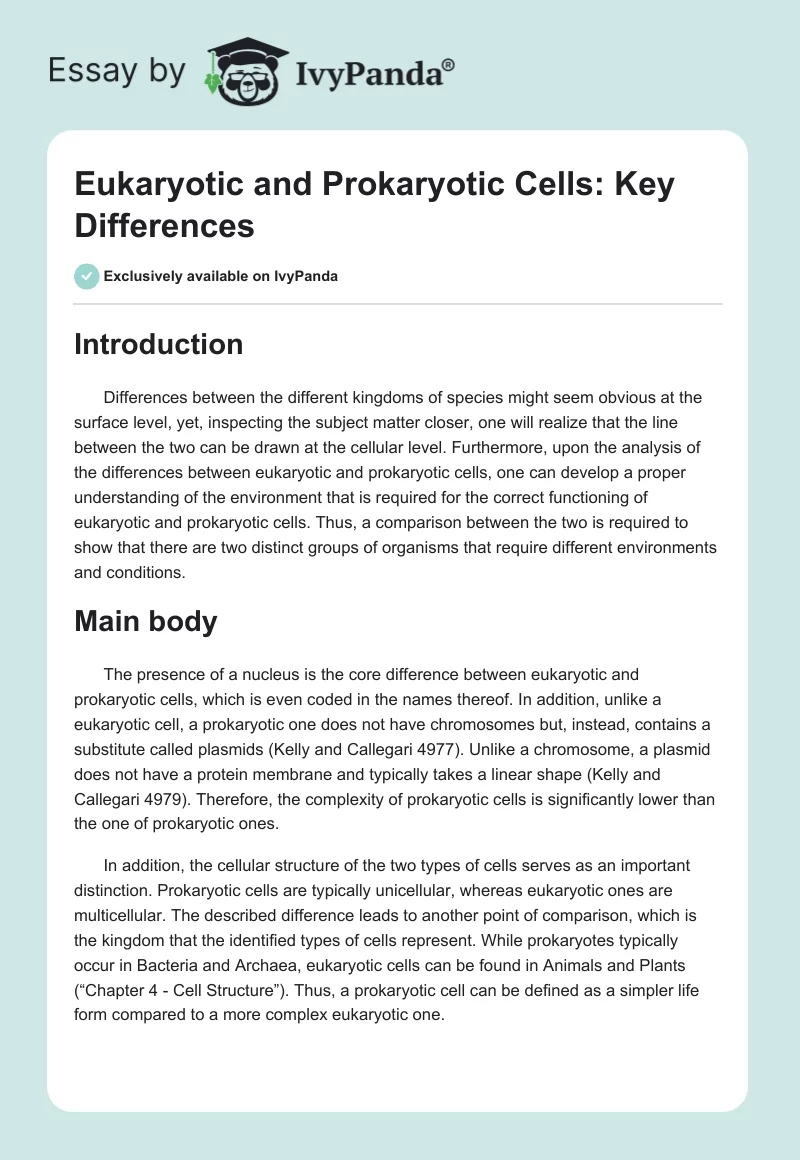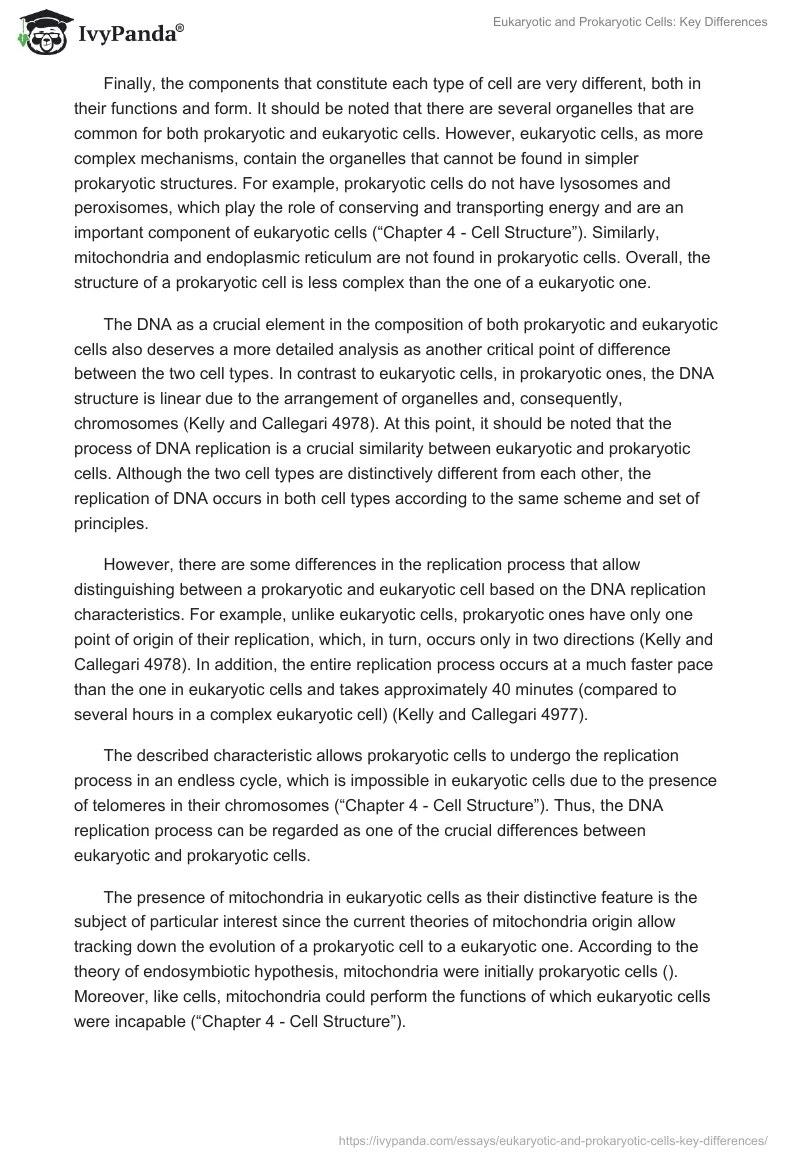Introduction
Differences between the different kingdoms of species might seem obvious at the surface level, yet, inspecting the subject matter closer, one will realize that the line between the two can be drawn at the cellular level. Furthermore, upon the analysis of the differences between eukaryotic and prokaryotic cells, one can develop a proper understanding of the environment that is required for the correct functioning of eukaryotic and prokaryotic cells. Thus, a comparison between the two is required to show that there are two distinct groups of organisms that require different environments and conditions.
Main body
The presence of a nucleus is the core difference between eukaryotic and prokaryotic cells, which is even coded in the names thereof. In addition, unlike a eukaryotic cell, a prokaryotic one does not have chromosomes but, instead, contains a substitute called plasmids (Kelly and Callegari 4977). Unlike a chromosome, a plasmid does not have a protein membrane and typically takes a linear shape (Kelly and Callegari 4979). Therefore, the complexity of prokaryotic cells is significantly lower than the one of prokaryotic ones.
In addition, the cellular structure of the two types of cells serves as an important distinction. Prokaryotic cells are typically unicellular, whereas eukaryotic ones are multicellular. The described difference leads to another point of comparison, which is the kingdom that the identified types of cells represent. While prokaryotes typically occur in Bacteria and Archaea, eukaryotic cells can be found in Animals and Plants (“Chapter 4 – Cell Structure”). Thus, a prokaryotic cell can be defined as a simpler life form compared to a more complex eukaryotic one.
Finally, the components that constitute each type of cell are very different, both in their functions and form. It should be noted that there are several organelles that are common for both prokaryotic and eukaryotic cells. However, eukaryotic cells, as more complex mechanisms, contain the organelles that cannot be found in simpler prokaryotic structures. For example, prokaryotic cells do not have lysosomes and peroxisomes, which play the role of conserving and transporting energy and are an important component of eukaryotic cells (“Chapter 4 – Cell Structure”). Similarly, mitochondria and endoplasmic reticulum are not found in prokaryotic cells. Overall, the structure of a prokaryotic cell is less complex than the one of a eukaryotic one.
The DNA as a crucial element in the composition of both prokaryotic and eukaryotic cells also deserves a more detailed analysis as another critical point of difference between the two cell types. In contrast to eukaryotic cells, in prokaryotic ones, the DNA structure is linear due to the arrangement of organelles and, consequently, chromosomes (Kelly and Callegari 4978). At this point, it should be noted that the process of DNA replication is a crucial similarity between eukaryotic and prokaryotic cells. Although the two cell types are distinctively different from each other, the replication of DNA occurs in both cell types according to the same scheme and set of principles.
However, there are some differences in the replication process that allow distinguishing between a prokaryotic and eukaryotic cell based on the DNA replication characteristics. For example, unlike eukaryotic cells, prokaryotic ones have only one point of origin of their replication, which, in turn, occurs only in two directions (Kelly and Callegari 4978). In addition, the entire replication process occurs at a much faster pace than the one in eukaryotic cells and takes approximately 40 minutes (compared to several hours in a complex eukaryotic cell) (Kelly and Callegari 4977).
The described characteristic allows prokaryotic cells to undergo the replication process in an endless cycle, which is impossible in eukaryotic cells due to the presence of telomeres in their chromosomes (“Chapter 4 – Cell Structure”). Thus, the DNA replication process can be regarded as one of the crucial differences between eukaryotic and prokaryotic cells.
The presence of mitochondria in eukaryotic cells as their distinctive feature is the subject of particular interest since the current theories of mitochondria origin allow tracking down the evolution of a prokaryotic cell to a eukaryotic one. According to the theory of endosymbiotic hypothesis, mitochondria were initially prokaryotic cells (). Moreover, like cells, mitochondria could perform the functions of which eukaryotic cells were incapable (“Chapter 4 – Cell Structure”).
However, since the oxidative processes that mitochondria performed were also essential for the proper functioning of eukaryotic cells, the latter acquired mitochondria via endosymbiosis (). As a result, mitochondria are a crucial component of eukaryotic cells nowadays, yet they are completely absent from prokaryotic ones. Providing opportunities for energy conversion, mitochondria in eukaryotes primarily serve to produce ATP, although it also has several other important functions.
Conclusion
Comparing eukaryotic and prokaryotic cells is necessary since it provides insightful results that may prompt a more nuanced understanding of the functioning of cells and tissues, as well as the factors that lead to the disruption in the processes of them. Thus, an improved approach toward treating patients will become possible. While the key distinction between eukaryotic and prokaryotic cells is the nucleus, which is absent in the latter, there are also numerous nuances that allow differentiating between the two cell types.
References
“Chapter 4 – Cell Structure.” Georgia Highlands College, n.d. Web.
Kelly, Thomas, and A. John Callegari. “Dynamics of DNA Replication in a Eukaryotic Cell.” Proceedings of the National Academy of Sciences, vol. 116, no. 11, 2019, pp. 4973-4982.


